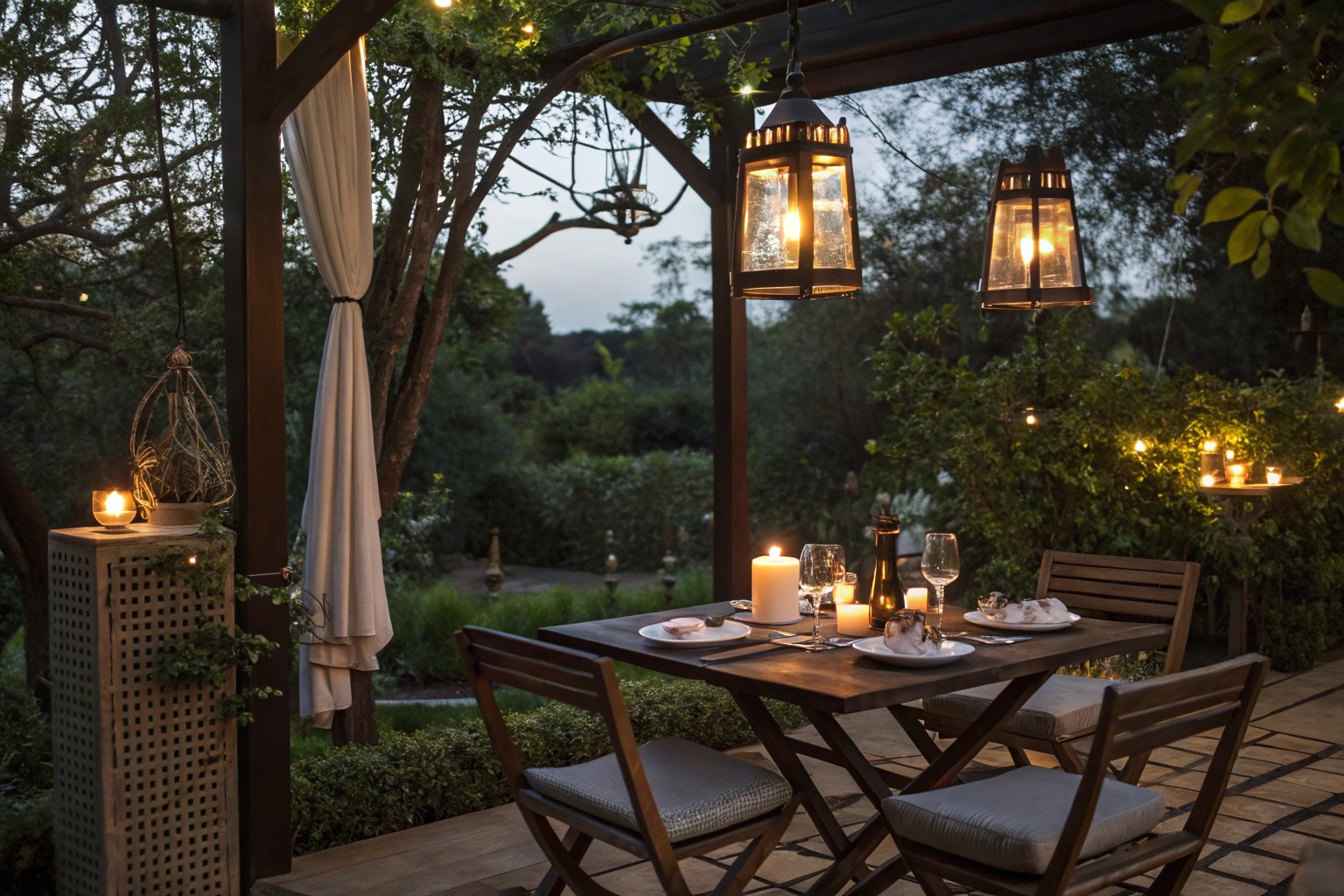Creating an intimate outdoor dining space transforms ordinary evenings into memorable romantic experiences, where thoughtful design elements work in harmony to craft the perfect ambiance. Whether you’re working with a sprawling garden or a compact patio, the principles of romantic outdoor design remain consistent: layered lighting, comfortable seating, and carefully curated natural elements that invite lingering conversations under the stars.
Foundation Planning: Location and Layout Considerations
Choosing Your Perfect Spot
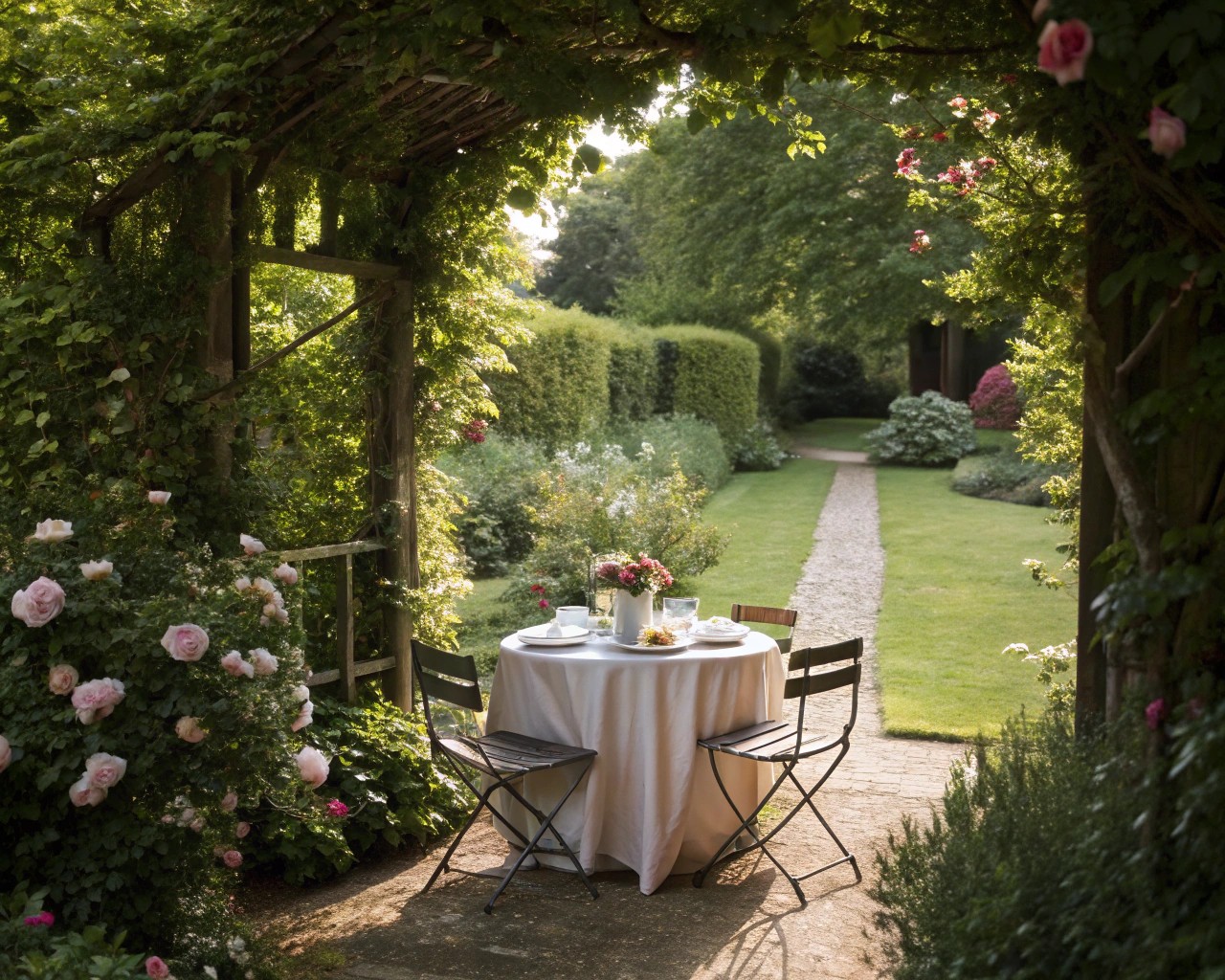
The success of any romantic outdoor dining area begins with selecting the ideal location within your outdoor space. Privacy and intimacy should be your primary considerations when evaluating potential sites. Look for naturally secluded areas that feel removed from everyday activities, such as corners of your garden, spots beneath mature trees, or alcoves created by existing landscape features.
I’ve found that areas with existing architectural elements—like garden walls, pergolas, or even the side of your home—provide an immediate sense of enclosure that enhances intimacy. These structures also offer practical advantages, such as mounting points for lighting and protection from prevailing winds.
Consider the sight lines from your home’s interior spaces. Positioning your dining area where it can be enjoyed from kitchen or living room windows creates a visual connection that makes the space feel integrated with your home’s overall design. This also allows for easy monitoring when entertaining and adds to the sense that your outdoor area is truly an extension of your living space.
Micro-Climate Assessment
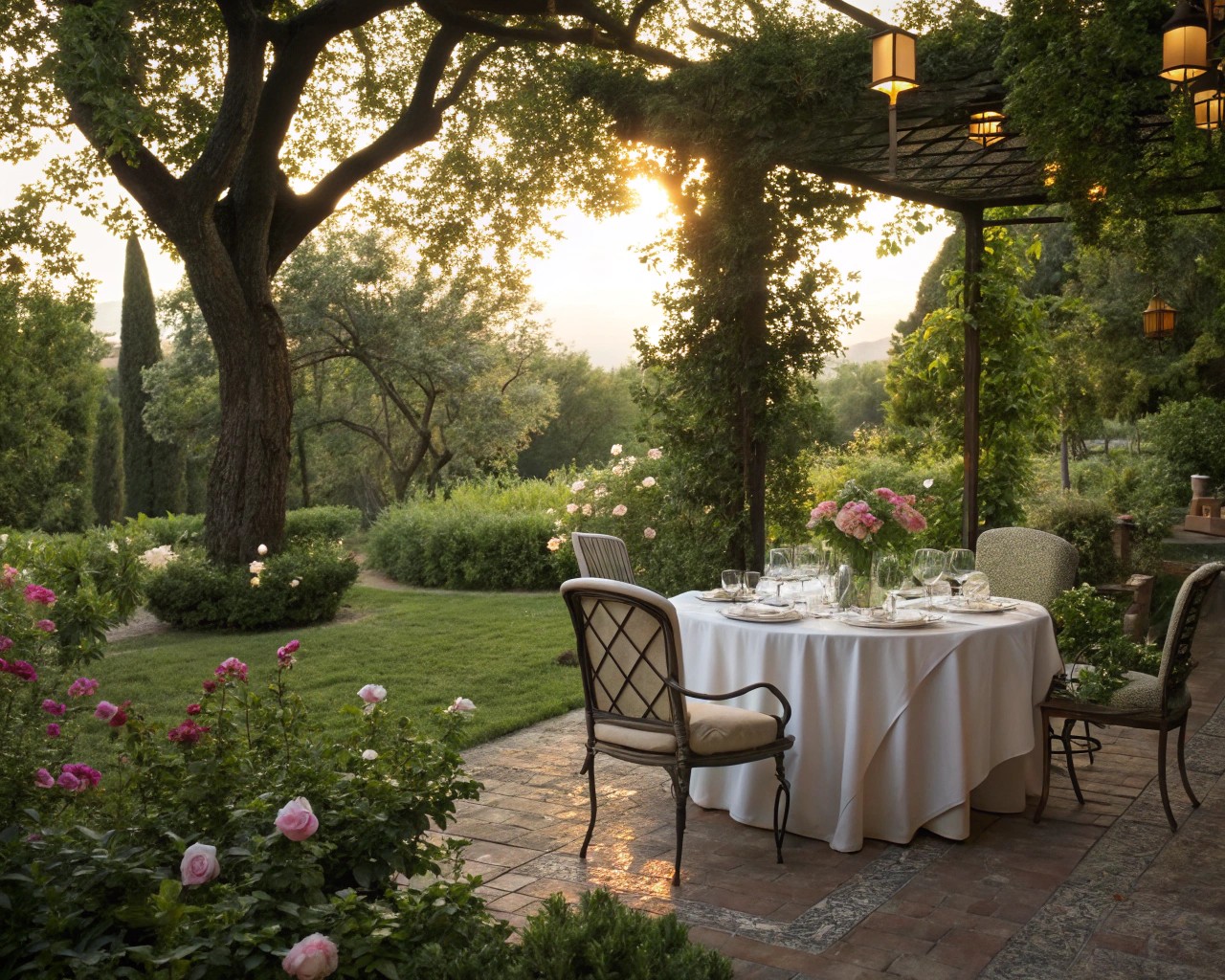
Understanding your site’s micro-climate ensures year-round usability and comfort. Observe sun patterns throughout the day, noting where shadows fall during typical dining hours. Morning sun exposure creates pleasant breakfast settings, while filtered afternoon light or evening shade proves ideal for dinner.
Wind patterns significantly impact comfort levels. Even gentle breezes can make dining unpleasant if they consistently blow across your seating area. Position your dining space to take advantage of natural windbreaks, or plan to install screens or plantings to create protection.
Creating Functional Zones
Effective outdoor dining areas benefit from zone planning that separates different activities while maintaining visual and physical connections. Your romantic dining area should feel distinct from more active spaces like children’s play areas or entertainment zones, yet remain accessible for practical needs.
Consider creating these complementary zones:
- Primary dining zone: The intimate table for two with appropriate clearance for chairs and movement
- Preparation area: A nearby surface for staging courses or beverages, such as a side table or bar cart
- Transition zone: A pathway that connects to your home’s interior without crossing other activity areas
- Buffer planting: Strategic vegetation that provides privacy screening without complete isolation
Furniture Selection: Balancing Comfort and Romance
Table Considerations for Intimate Dining
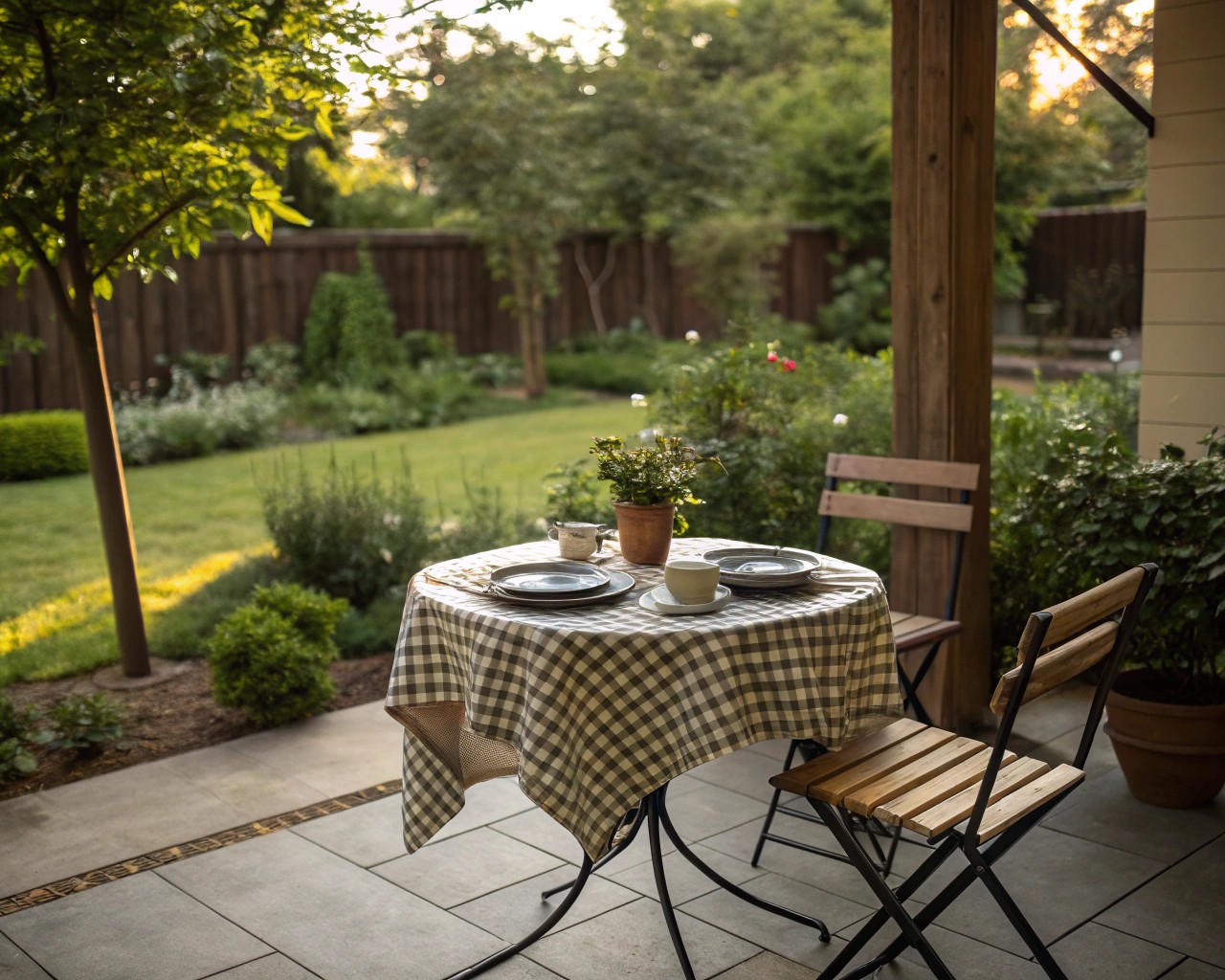
The dining table serves as the focal point of your romantic outdoor space, and its selection impacts both functionality and atmosphere. Round tables excel at creating intimate conversations by allowing both diners to face each other directly without the barrier of table corners. For spaces where a round table isn’t practical, square bistro tables offer similar intimacy benefits while fitting into smaller areas.
Size matters significantly in romantic settings. Tables ranging from 30 to 36 inches in diameter provide sufficient space for place settings, centerpieces, and serving dishes while maintaining the close proximity that encourages conversation. Avoid oversized tables that force diners to sit far apart, as this undermines the intimate atmosphere you’re creating.
Material selection should prioritize durability and weather resistance while supporting your desired aesthetic. Powder-coated steel with decorative elements, such as hand-forged scrollwork, adds romantic charm while withstanding outdoor conditions. Natural wood options like teak develop beautiful patina over time, though they require more maintenance.
Seating That Invites Lingering
Comfortable seating encourages the leisurely dining pace that enhances romantic experiences. Look for chairs with ergonomic design and adequate cushioning, as romantic meals often extend well beyond typical dining durations. Rattan and wicker chairs with weather-resistant cushions provide comfort while maintaining an elegant, romantic aesthetic.
Consider these seating features for optimal romantic dining:
- Armrests for relaxed posture during extended conversations
- Weather-resistant cushions in soft, romantic colors like dove white or cream
- Adequate back support to prevent fatigue during long meals
- Appropriate seat height that pairs well with your chosen table
Complementary Furniture Elements
A thoughtfully selected bar cart adds both functionality and style to romantic outdoor dining setups. Mobile serving pieces allow you to keep beverages, desserts, and dining accessories within reach without cluttering your intimate table setting. Choose carts with weather-resistant finishes and storage capacity for essentials like wine glasses, napkins, and serving pieces.
Ottoman seating or small side tables provide flexible options for extending the dining experience. These pieces accommodate the transition from formal dining to relaxed conversation, allowing couples to shift positions while maintaining the intimate atmosphere.
Lighting Design: Creating Magical Ambiance
Layered Lighting Principles
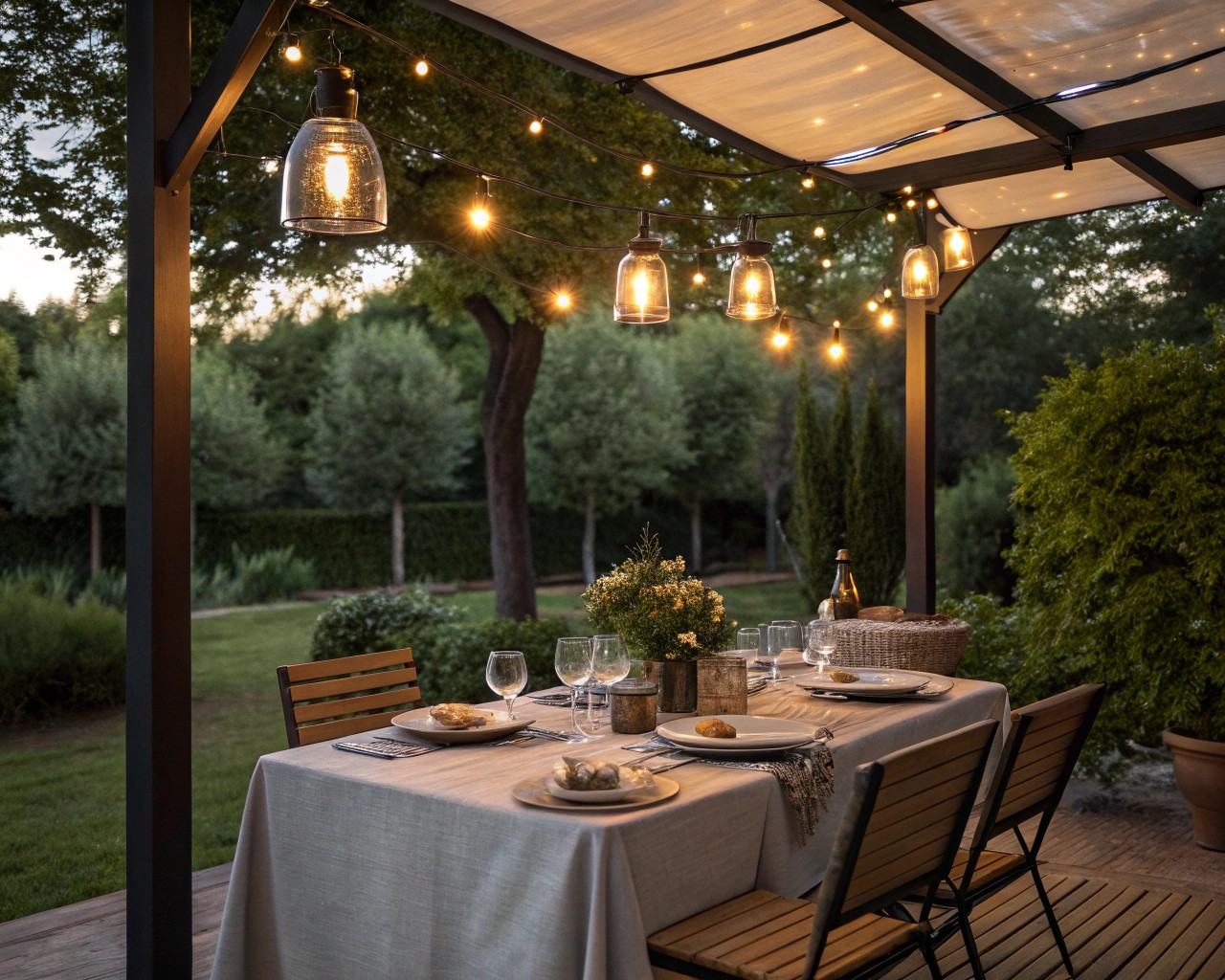
Successful romantic outdoor lighting employs multiple light sources at varying heights and intensities to create depth and visual interest. This layered approach allows you to adjust the ambiance throughout the evening, from practical illumination during meal preparation to soft, romantic glow for intimate conversation.
The three essential lighting layers include:
Ambient lighting: Provides overall illumination and safety, typically through string lights or overhead fixtures
Task lighting: Ensures visibility for dining activities without overwhelming the romantic atmosphere
Accent lighting: Creates focal points and adds dramatic interest through candles, lanterns, or uplighting
String Lights and Overhead Options
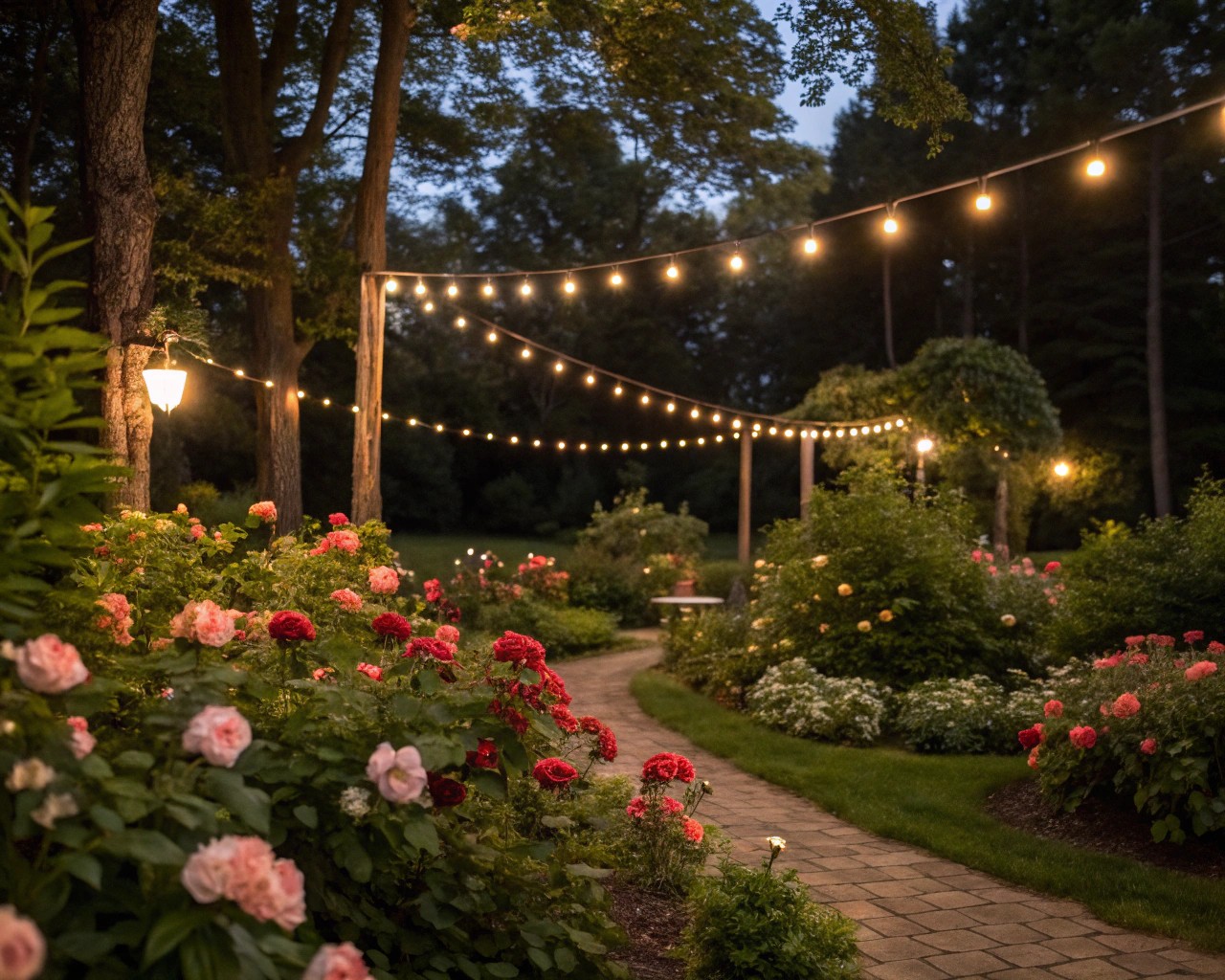
Fairy lights and string lights remain the quintessential choice for romantic outdoor dining, offering warmth and charm that instantly transforms any space. Position string lights to create a “ceiling” effect over your dining area by running them between trees, pergola posts, or specially installed mounting points. The gentle twinkle provides adequate illumination for dining while maintaining intimate ambiance.
When installing string lights, consider these practical guidelines:
- Height placement: Position lights 8-10 feet above the dining surface to avoid interference with conversation while providing sufficient coverage
- Spacing patterns: Create gentle curves or zigzag patterns rather than rigid straight lines for more organic, romantic appeal
- Power source: Choose between solar-powered options for flexibility or hardwired systems for consistent performance
Pendant lights offer more substantial illumination while maintaining romantic appeal. Weather-rated pendant fixtures positioned over the dining table provide focused light for meal service while contributing to the overall design aesthetic. Look for fixtures with warm-toned LED bulbs that complement rather than compete with other lighting elements.
Table-Level and Accent Lighting
Candles remain unmatched for creating romantic atmosphere, but outdoor use requires careful consideration of safety and practicality. Hurricane lanterns or enclosed candle holders protect flames from wind while preventing wax spillage on your table surface. LED candles with realistic flickering effects offer the romantic ambiance of real candles with improved safety and longevity.
Portable table lamps designed for outdoor use provide adjustable lighting that can be repositioned as needed throughout the evening. Battery-powered or rechargeable options eliminate the need for nearby electrical outlets while offering consistent illumination levels.
Consider incorporating lanterns at various heights around your dining area to create depth and visual interest. Group lanterns of different sizes on nearby surfaces, or hang them from shepherd’s hooks positioned strategically around the seating area.
Safety and Practical Considerations
Ensure all electrical fixtures meet appropriate UL ratings for outdoor use. UL Wet-rated fixtures withstand direct exposure to rain and moisture, while UL Damp-rated options suit covered areas with indirect moisture exposure. This distinction affects both safety and longevity of your lighting investment.
Plan lighting controls that allow easy adjustment without leaving the dining area. Remote-controlled or smart lighting systems enable seamless transitions from bright task lighting during meal setup to dim, romantic illumination for intimate conversation.
Plant Selection and Landscape Integration
Romantic Plant Palette
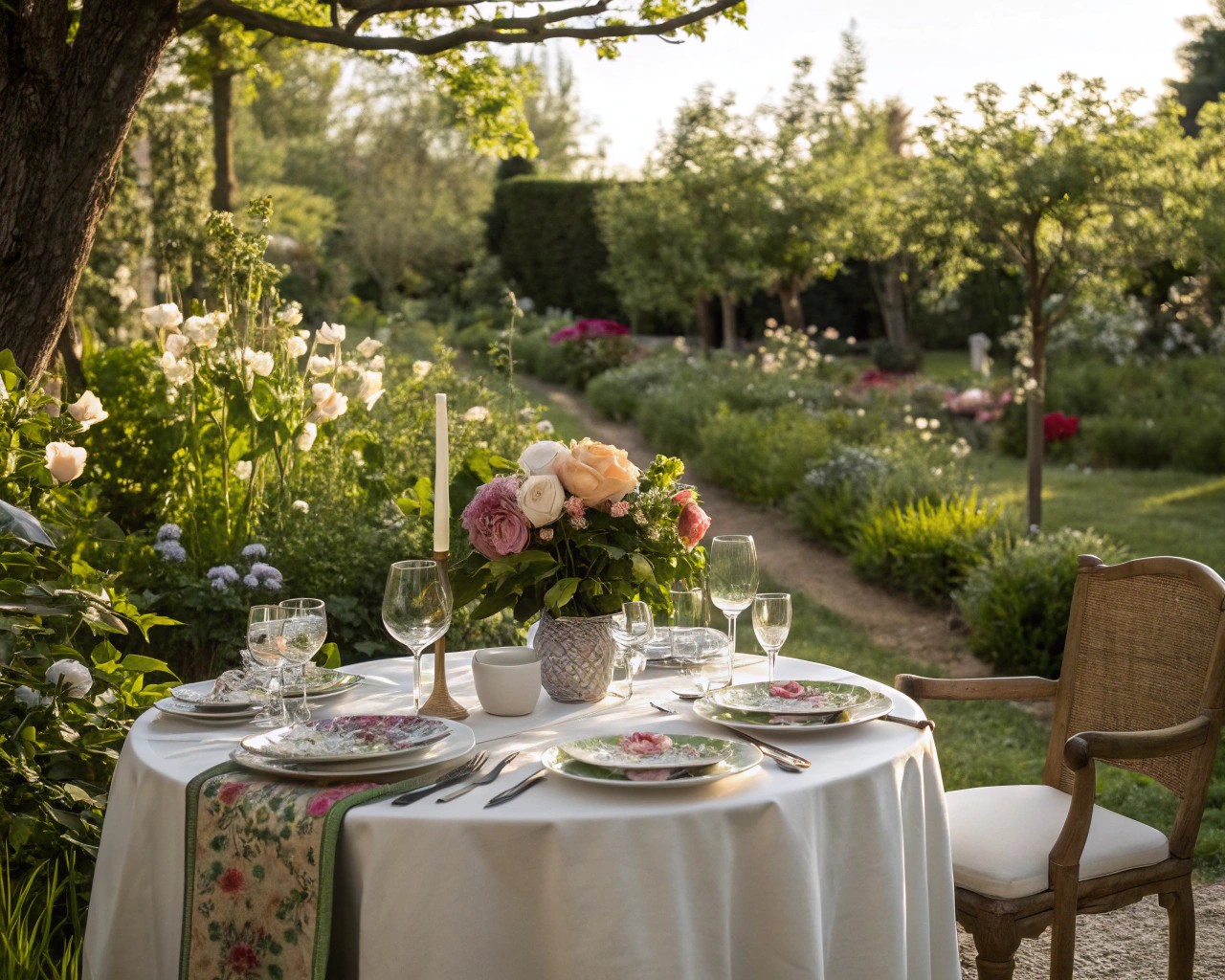
The right plant selection transforms your dining area from a simple outdoor space into a romantic garden room. Fragrant flowering plants provide the sensory experience that makes outdoor dining memorable, while soft textures and gentle colors create visual appeal that enhances the intimate atmosphere.
Roses remain the classic choice for romantic gardens, offering both visual beauty and intoxicating fragrance. Climbing varieties trained on arbors or trellises create natural architecture around your dining space, while shrub roses planted in nearby borders provide seasonal color and scent. Consider these romantic rose varieties:
- ‘Charles de Mills’: Intensely fragrant with soft pink blooms perfect for romantic settings
- Climbing roses: Trained over pergolas or arbors to create intimate enclosure
- Repeat-flowering varieties: Ensure blooms throughout the dining season
Night-scented plants prove especially valuable for evening romantic dining. Jasmine varieties release intensified fragrance as temperatures cool, creating an enchanting atmosphere for intimate dinners. Night-blooming stock and nicotiana provide additional evening fragrance options that complement rather than compete with dinner aromas.
Creating Intimate Enclosure
Strategic planting creates the sense of enclosure that makes outdoor dining areas feel intimate and secluded. Layered plantings at varying heights establish natural walls without completely blocking views or airflow. This approach maintains the open-air feeling while providing privacy from neighboring properties or other garden areas.
Design your plantings using these principles:
Background layer: Tall shrubs or small trees (8-12 feet) create the primary screening
Middle layer: Medium shrubs and ornamental grasses (3-6 feet) fill visual gaps
Foreground layer: Perennials and seasonal flowers (1-3 feet) provide color and detail
Ornamental grasses deserve special consideration for romantic dining areas, as their movement in gentle breezes adds dynamic interest while creating soft, naturalistic transitions between planted areas. Species like Stipa gigantea catch and reflect light beautifully, especially when backlit by evening sun or landscape lighting.
Seasonal Interest and Maintenance
Plan your romantic garden for four-season appeal by selecting plants that provide interest throughout the year. Evergreen shrubs like boxwood or sweet osmanthus maintain structure during dormant seasons, while flowering trees such as magnolias provide spectacular spring displays.
Consider maintenance requirements when selecting plants for around dining areas. Low-maintenance perennials that return reliably each year reduce ongoing care while providing consistent romantic appeal. Self-seeding annuals like foxgloves create naturalistic plantings that evolve over time while requiring minimal intervention.
Avoid plants that drop messy fruits, have thorny growth habits, or attract problematic insects near dining areas. While these plants may be beautiful in other garden areas, they can detract from the comfort and cleanliness essential for outdoor dining.
Table Styling and Accessories
Linens and Table Settings
Outdoor table linens serve both practical and aesthetic functions in romantic dining setups, protecting table surfaces while setting the foundation for elegant presentations. Unlike indoor dining, outdoor table styling must account for wind, moisture, and temperature variations while maintaining romantic appeal.
Choose fabrics specifically designed for outdoor use, or select indoor linens that can withstand occasional outdoor conditions. Layered tablecloths create romantic, shabby-chic appeal while providing practical benefits. The bottom layer offers basic protection, while a decorative top layer can be easily removed for washing or replacement.
Consider these table styling elements:
- Table runners: Define the dining area while allowing natural table material to show through
- Coordinated napkins: Choose colors that complement your plant palette and lighting scheme
- Placemats: Provide individual place definition while protecting linens from spills
- Cloth weights: Prevent wind displacement without detracting from romantic appeal
Centerpieces and Decorative Elements
Romantic outdoor centerpieces should complement rather than compete with the natural beauty surrounding your dining area. Low, horizontal arrangements maintain sight lines between diners while adding color and fragrance to the table setting. Fresh flowers from your garden create immediate connection between the dining experience and the surrounding landscape.
Candle arrangements provide both illumination and romantic focal points, but require protection from wind in outdoor settings. Hurricane lanterns, glass cloches, or enclosed candle holders maintain flame stability while contributing to the overall lighting scheme. Group candles of varying heights for visual interest while ensuring they don’t obstruct conversation.
Consider these centerpiece guidelines:
- Height restriction: Keep arrangements below 12 inches to maintain eye contact across the table
- Fragrance balance: Choose flowers with subtle scents that won’t compete with food aromas
- Weather resistance: Select containers and materials that withstand outdoor conditions
- Flexibility: Design arrangements that can be easily adjusted or removed as needed
Practical Accessories
Serving pieces designed for outdoor use ensure both functionality and style throughout the dining experience. Weather-resistant serving trays, bread baskets, and beverage containers maintain the romantic aesthetic while providing practical solutions for outdoor entertaining.
Temperature control accessories extend the usability of your romantic dining area into cooler seasons. Outdoor heaters, fire pits, or warming devices allow comfortable dining during transitional weather while adding to the romantic ambiance. Choose heating elements that complement your overall design aesthetic rather than appearing purely functional.
Seasonal Adaptations and Year-Round Use
Spring and Summer Optimization
Warm weather seasons offer the greatest opportunities for romantic outdoor dining, but success requires attention to sun protection and ventilation. Pergolas, umbrellas, or shade sails provide necessary relief from intense midday sun while maintaining the open-air feeling essential to outdoor dining.
Cooling strategies become essential during peak summer months. Position your dining area to take advantage of natural breezes, or install outdoor fans to improve air circulation. Misting systems can provide cooling relief in dry climates without overwhelming moisture levels that damage furnishings or food presentation.
Plant selection for warm seasons should emphasize drought-tolerant species that maintain appearance without excessive watering. Container gardens allow flexibility in plant placement while simplifying maintenance and seasonal changes.
Fall and Winter Considerations
Extending romantic outdoor dining into cooler seasons requires strategic heating and weather protection. Fire pits or outdoor fireplaces create natural gathering points while providing warmth and romantic ambiance. Position heating elements to benefit both diners without creating safety hazards or excessive heat imbalance.
Wind protection becomes increasingly important as temperatures drop. Temporary screens, outdoor curtains, or strategic plantings can significantly improve comfort levels during cooler weather dining. These elements should be easily removable during warmer seasons to maintain the open feeling preferred for summer dining.
Protective storage for cushions, linens, and decorative accessories ensures their longevity while simplifying seasonal transitions. Weather-resistant storage containers positioned conveniently near the dining area allow quick setup and breakdown as weather conditions change.
Maintenance Scheduling
Seasonal maintenance keeps romantic outdoor dining areas looking their best throughout the year. Develop routines that address both plant care and furniture maintenance without overwhelming your available time for enjoyment.
Spring maintenance tasks:
- Deep cleaning of furniture and accessories
- Plant pruning and fertilization
- Lighting system inspection and bulb replacement
- Cushion and fabric assessment for replacement needs
Fall preparation activities:
- Plant protection for winter weather
- Furniture winterization or storage
- Lighting system weatherproofing
- Drainage system clearing and maintenance

